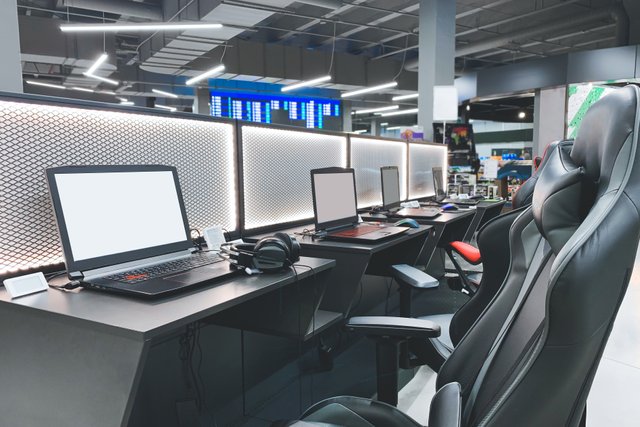For those unfamiliar with the components of a gaming laptop, it is difficult to judge for yourself which laptop is more or less powerful. That’s why below is an overview of the different elements of a gaming notebook to help you choose the laptop that best suits your needs.
Main features of gaming notebooks
First, We must know the main characteristics of a gaming notebook and how they differ from PC. Gaming Laptops are superior to traditional notebooks (these do not usually support the performance necessary for high-definition games).

Graphics Card
To talk about the components of a laptop for gamers, I’ll start with the graphics card. This element must be well accompanied by a processor according to its performance, which I will detail in the next paragraph. If you want to play 1080p at medium quality in most games, a GTX 1650 is enough. It is also the minimum that should be considered for the purpose of a Gaming Laptop and to achieve a minimum of fluidity and image details . . A GTX 1660 Ti or higher is already a good graphics card for gaming at 1080p and high/ultra quality depending on the game, and the RTX 3060 is already an outlier for 1080p.
Processors
The nerve center of a laptop is the processor, and it must accompany the chosen graphics card. A processor like the Core i5-10300H is enough to move a GTX 1660 Ti, but from there a Core i7-10750H would be more recommended. Processors like the Core i7-10850H are suitable for graphics cards like the RTX 3070 if you have a 120 or 144 Hz display on your laptop. For 4K gaming with high-end graphics, a Core i7-10750H is sufficient. Ryzen processors are generally more powerful but have lower availability.
Screen
As for the size of the screen, it is recommended that it be greater than 14 inches. These types of screens are very useful for editing videos or photos. And in terms of resolution, it is recommended that it be Full HD. It provides good response times, although the color quality is usually not as good as IPS panels, which are often used in laptops that exceed 800 or 900 euros. They generally use 60Hz panels, although there are a growing number of displays with 120Hz and even 144Hz refresh rates. They allow to see the games much more fluidly and will allow the gamer to respond better to changes in the environment, although this improvement will be more evident for some people than for others.
For these screens, a moderately powerful graphics card is recommended, such as a GTX 1650 or a GTX 1660 Ti, and reach those frame rates in a greater number of games. Still, in esports or electronic sports games – Overwatch, League of Legends, etc. Hitting 120Hz on cards like the GTX 1650 will not be uncommon if graphics settings are properly adjusted.
4K UHD (3840 × 2160 pixels) type panels are usually of the IPS type and have great image quality. However, it can be a bit difficult to adapt to it, since many have a higher than average input latency, and therefore some users may notice that the images are jumping. Generally, that passes once you get used to the quality of the screen.
My take on 4K displays on a gaming laptop is that it’s impractical, as it will require a more powerful graphics card, and it doesn’t ensure smooth gameplay. Unless, of course, you include a GTX 1080-type graphics card or lower the graphics quality quite a bit. A 17.3-inch 4K UHD display throws out a pixel density of around 280 PPI, which will look sharp even from 4 to 8 inches away. Since the game is played at a distance of half a meter or more from the laptop screen, so much sharpness is unnecessary.
Random Access Memory
RAM is one of the few upgradeable items in a gaming notebook, and it’s usually easily accessible, usually by removing a few screws and a cover. 8 GB is enough to get good performance from a GTX 1050 Ti-type graphics card downwards, although there are some games that will require 12 or 16 GB of RAM to work properly. Gaming computers have at most two memory banks for a total of up to 32 GB. Some cheaper equipment could arrive with only one memory bank, so it is a point to look at before buying, especially if it is occupied by an 8 GB module and you want to have 16 GB since it will be lost. Games are quite demanding on the computer. 8 GB and up is recommended to be able to run multiple tasks at once and play for long hours.
Storage
It is recommended to purchase a notebook that has an SSD equal to or greater than 256 GB and an HDD equal to or greater than 500 GB. In a gaming laptop, it is almost essential that it be accompanied by an SSD of at least 128 GB so that the operating system runs perfectly smoothly. Installing the operating system and the games on the same hard drive can and will slow down the computer in general, and it will be especially noticeable when loading maps, although this has to do with the low speed of reading files on smaller hard drives versus SSDs.
The difference between a SATA3 type SSD and a PCIe 3.0 x4 NVMe type is very noticeable in terms of both sequential and random read/write, but in a normal gaming computer, you will not notice the difference. The recommended thing, due to how SSDs work, is one of at least 250 GB, and there is no major problem in opting for a cheap SATA3 SSD. The PCIe can come in handy to load game maps even faster, but the difference is not noticeable in most titles.
Today’s gaming notebooks will have at least one or two slots for M.2 type SSDs, which are card size typically 22 x 80mm. They will also have one or two easily accessible 2.5-inch drive bays, at least one occupied by a hard drive, which can usually be replaced by a 2.5-inch SATA3 SSD. If you have an optical disc drive, an adapter is sold for some laptop models that allow you to install an additional 2.5-inch drive.
Sound Card
Gaming laptops have a tendency to be noisy, and it is, therefore, ideal to have a headset close at hand. And if it’s not to avoid laptop noise, you’ll need a good headset to communicate in the myriad of online games out there today. Laptop sound quality improvements focus on improved codecs and amplification systems, hi-res sound, etc. They are improvements that if you do not have good headphones will go unnoticed.
How much does a gaming notebook cost?
If you are looking to buy a gaming notebook in Germany, you may find it from CLS Computer. To meet all the requirements you can buy your gaming notebooks cheaply.
What are the advantages of gaming laptops?
With technological advances, the notebook market has evolved, creating excellent notebooks, whether for those who are just beginning to explore the gamer world or even the most advanced gamers. Each manufacturer has focused on, expanding the speed of notebooks, reducing the size, which are the main advantages. Compared to a PC, gaming notebooks offer better portability, lighter weight, less heating, all components in one place.


